Application of HFCT and UHF Sensors in On-Line Partial Discharge Measurements for Insulation Diagnosis of High Voltage Equipment
Abstract
:1. Introduction
2. PD Sensors and Frequency Converter for PD Measurements in UHF
2.1. HFCT Sensors


- -
- The sensitivity is not so pulse shape dependent as in conventional PD measuring instruments.
- -
- The signal to noise ratio (SNR) can be improved, analyzing the data in certain frequency bands.
- -
- High sensitivity is obtained when the sensors are located closed to the PD source and also when they are far from it. In a power cable system, when a PD pulse propagates through the cable shield, although the high frequency content of the signal is filtered, the pulse can be measured at distances exceeding one kilometer holding their spectral content up to units of megahertz [23].
- -
- If two or more HFCT sensors are placed in a HV installation, the measurement of the PD pulses with a common time reference allows the determination of the location of defects by the time-of-flight analysis.
- -
- PD pulses waveform can be recorded for post processing purposes. The recorded signals can be classified by the characterization of the pulse shape with the aim of discriminate different PD or noise sources. A proper classification of the recorded pulses and a subsequent analysis of the associated phase resolved PD (PRPD) patterns, improves the sensibility in the detection of defects and facilitates more accurate diagnoses.
- -
- For the frequency range specified, ferrite cores are commonly available and a high quality HFCT sensor manufacture results easy and inexpensive.

2.2. UHF Sensors

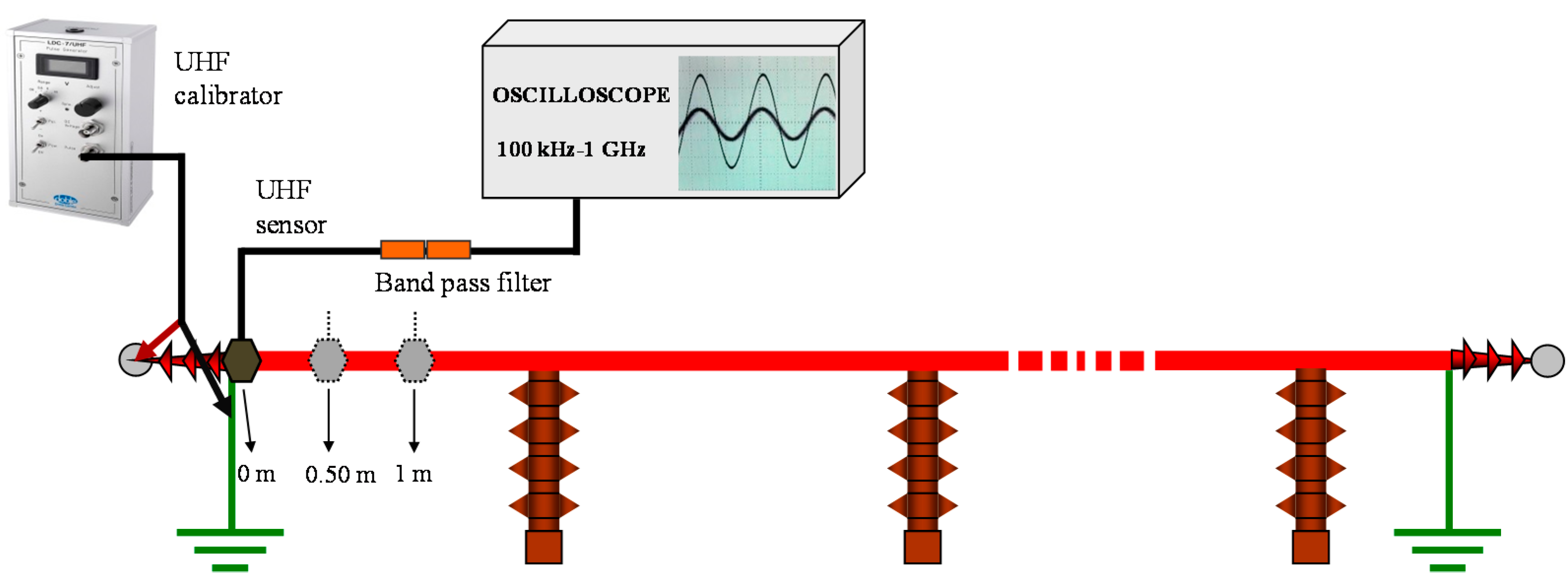

- -
- High immunity to electric noise, interferences and corona discharges in air, since the frequency spectrum of these signals in the UHF range is very low and in some emplacements negligible.
- -
- High sensitivity in PD detection inside shielded GIS compartments, metal enclosed switchgears and transformer tanks, due to the inner electrical resonance, very low inherent losses and low noise levels.
- -
- Possibility of PD source location. In the case of GIS and transformers the location is performed using several sensors and analyzing the arrival times of the pulses (time-of-flight measurements).
- -
- Accurate defect locations are achieved in cables and accessories due to the selectivity in the distance that this technique presents.
- -
- Possibility to discriminate between internal and external defects to the HV equipment under consideration.



2.3. UHF-HF Converter
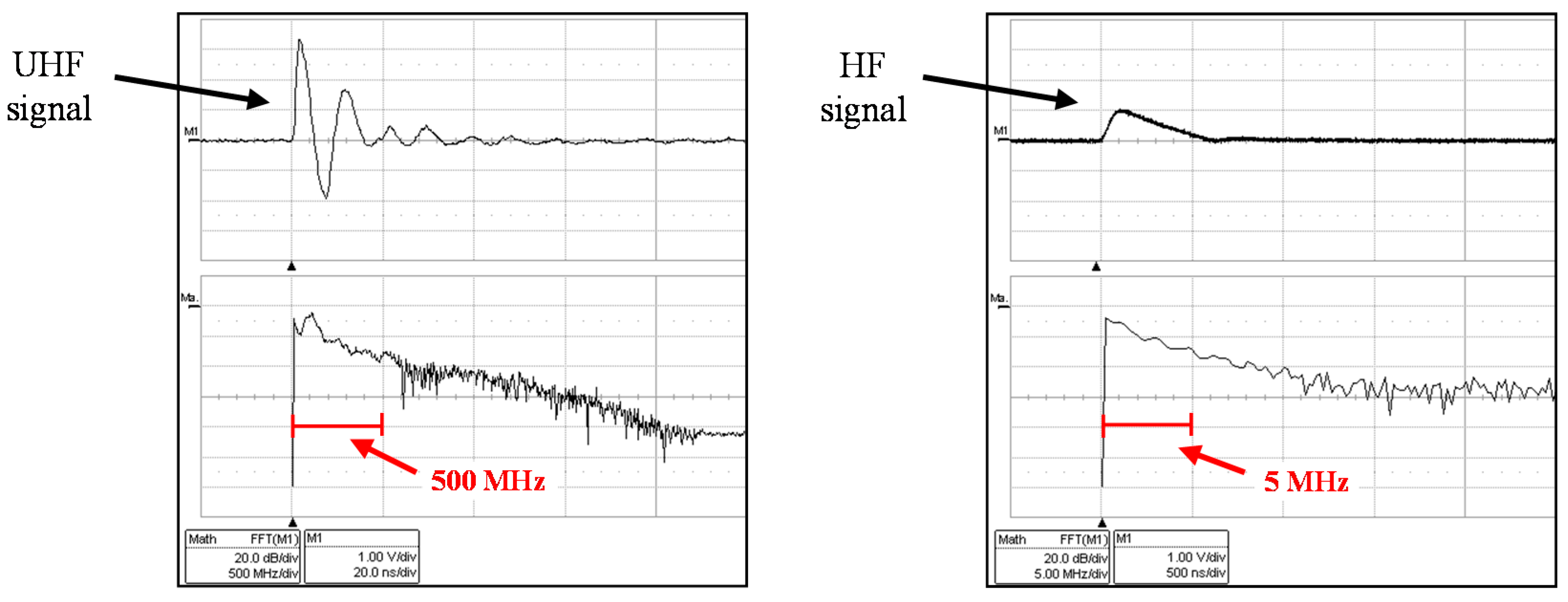
3. Measuring Instrument and Signal Processing Tools
3.1. Measuring Instrument

3.2. Signal Processing Tools
3.2.1. Noise Filtering Tool
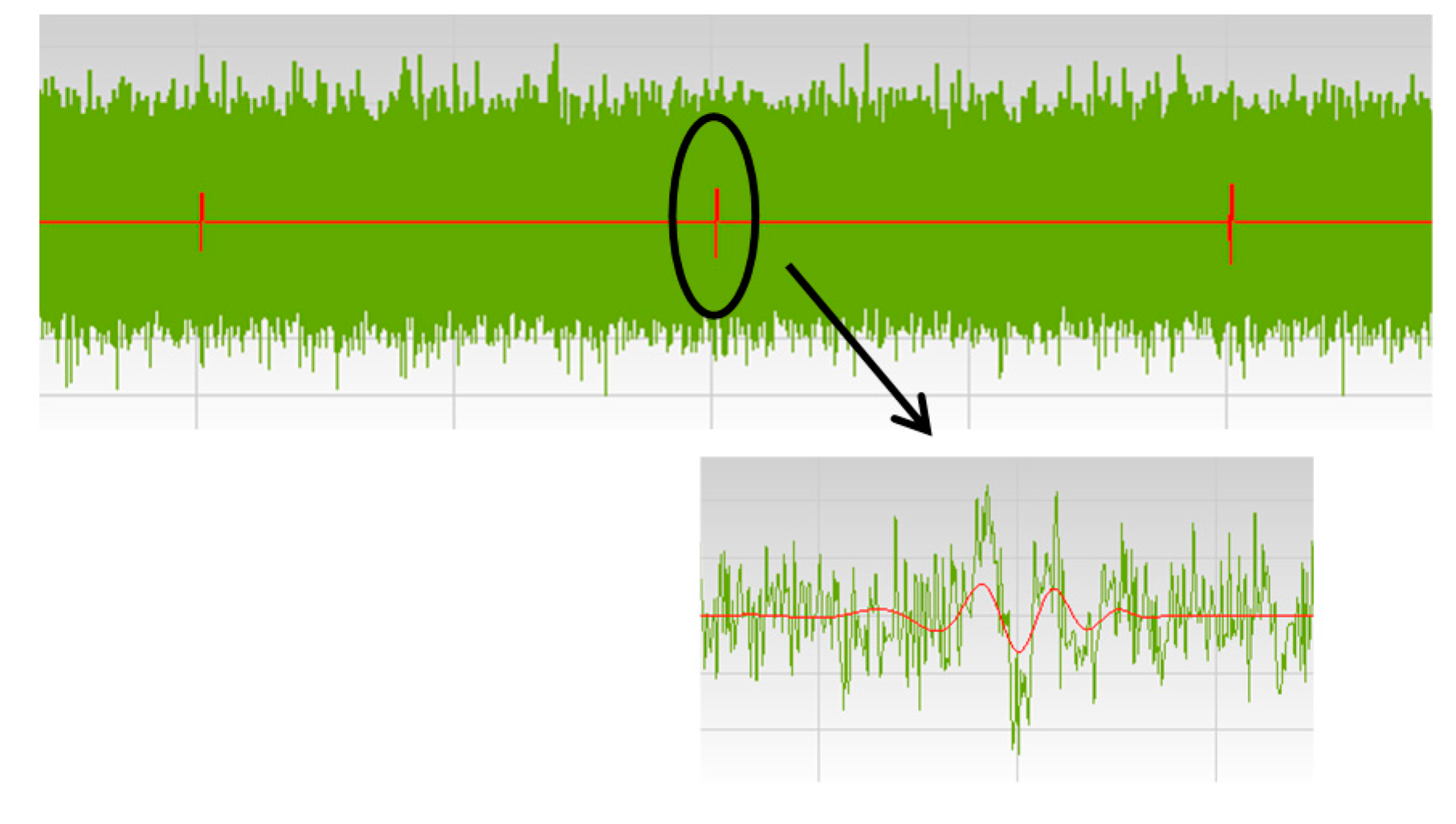
3.2.2. Classification by Location Tool
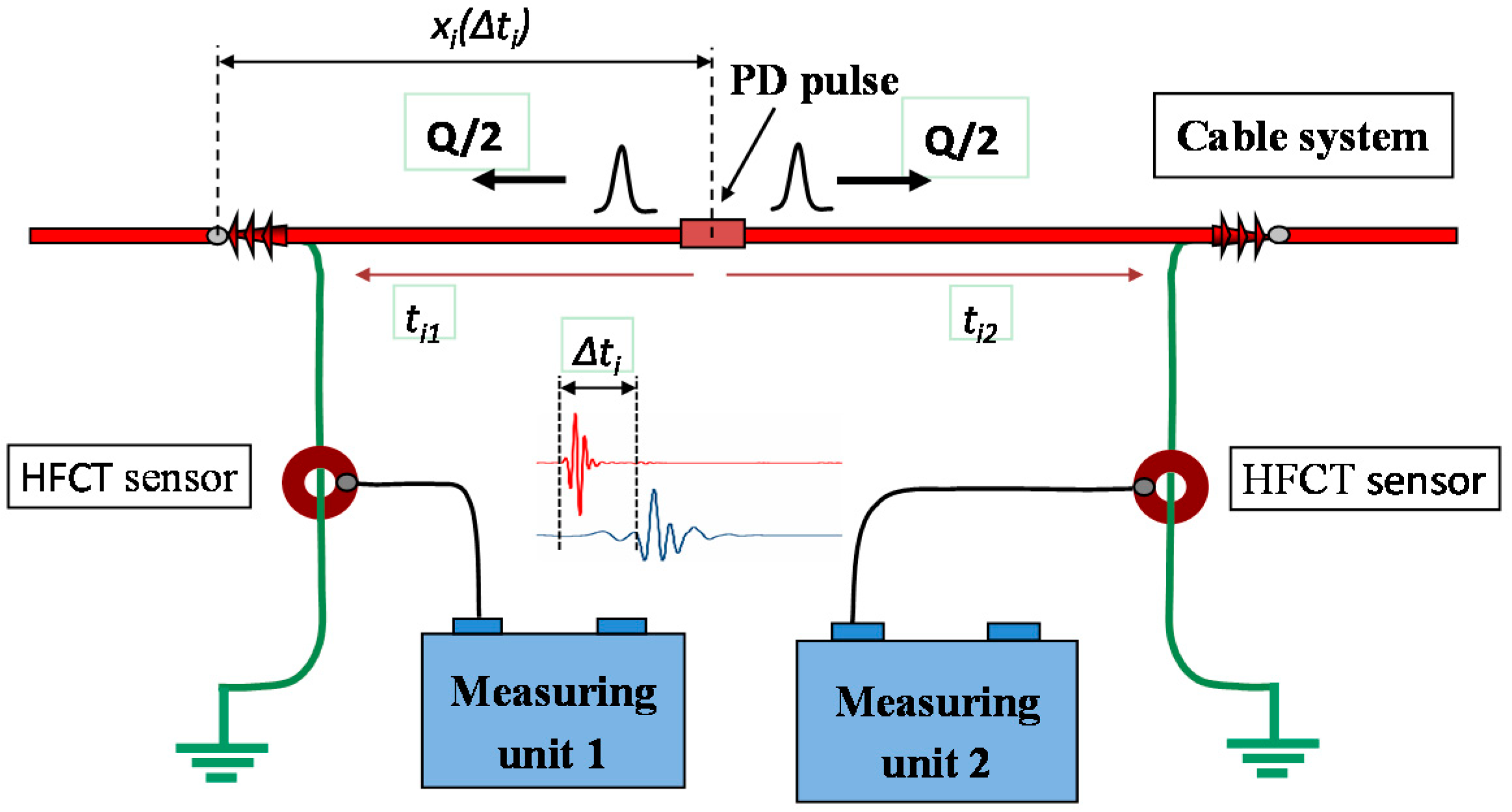

3.2.3. PD clustering Tool

4. HF and UHF PD Measurement
4.1. Generation of PD Sources
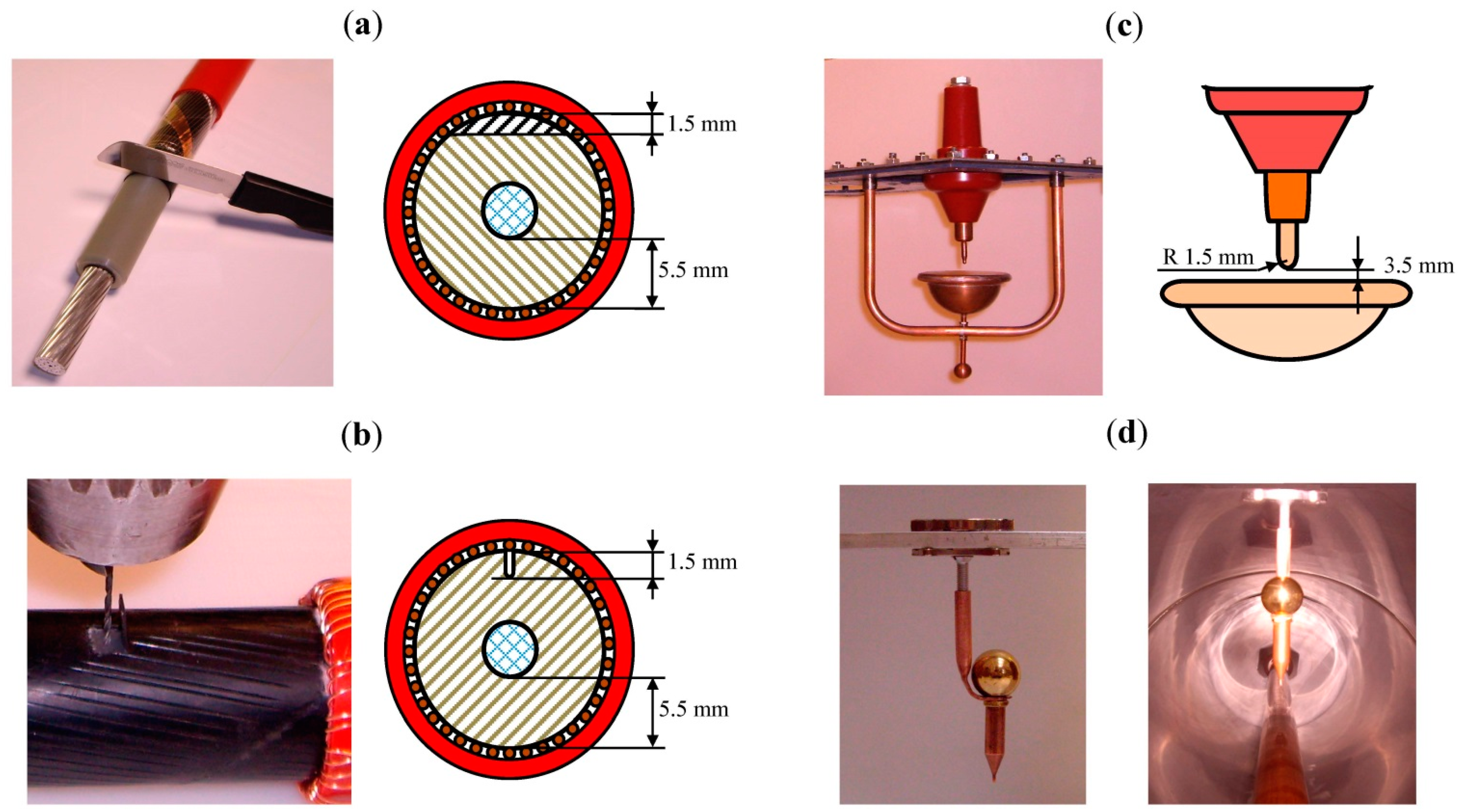

4.2. Experimental Setup
- (a)
- Substation. Formed by the GIS compartment described above and a 12/20 kV XLPE cable of 15 m length and a 240 mm2 aluminum conductor. This cable interconnects by a plug-in terminal (position B) and a cable junction (position C) the GIS compartment with the cable system.
- (b)
- Cable system. A 12/20 kV XLPE cable system with a 240 mm2 aluminum conductor was configured with a total length of 867 m. The line was composed by two joined cable coils with lengths of 350 and 517 m. The connection between them (position D) was made with a splice.
- (c)
- Distribution grid. To simulate the continuity of the distribution grid a 12/20 kV XLPE cable system with a total length of 585 m and a 240 mm2 aluminum conductor was connected to the cable system. The connection (position E) was made simulating a junction of the switchgear cabinets of a distribution transformer substation.

| Insulation Defect | Location |
|---|---|
| 1. Corona in a GIS compartment | A (inside the GIS chamber) |
| 2. Internal defect type 1 in a cable termination | C (in the power cable) |
| 3. Corona in air | C (in the power cable) |
| 4. Internal defect type 2 in one of the cable terminations of a splice | D (in the power cable) |
4.3. Measuring Procedure
| Invasive UHF Sensors | Position |
|---|---|
| UHF 1 | A |
| UHF 2 | B |
| Non-invasive HFCT Sensors | Position |
| HFCT 1 | C |
| HFCT 2 | E |
| Non-invasive UHF Sensor | Position |
| Mobile UHF 3 | In different emplacements along the HV installation to determine the exact PD source location |
| Measuring Instrument | Channel | Sensor |
|---|---|---|
| Measuring Unit 1 | Channel 1 | Invasive UHF 1 (position A) |
| Channel 2 | Invasive UHF 2 (position B) | |
| Channel 3 | HFCT 1 (position C) | |
| Channel 4 | Mobile non-invasive UHF 3 | |
| Measuring Unit 2 | Channel 1 | HFCT 2 (position E) |
| Rest of channels | Free for more sensors if required |
4.4. Experimental Results and Analysis


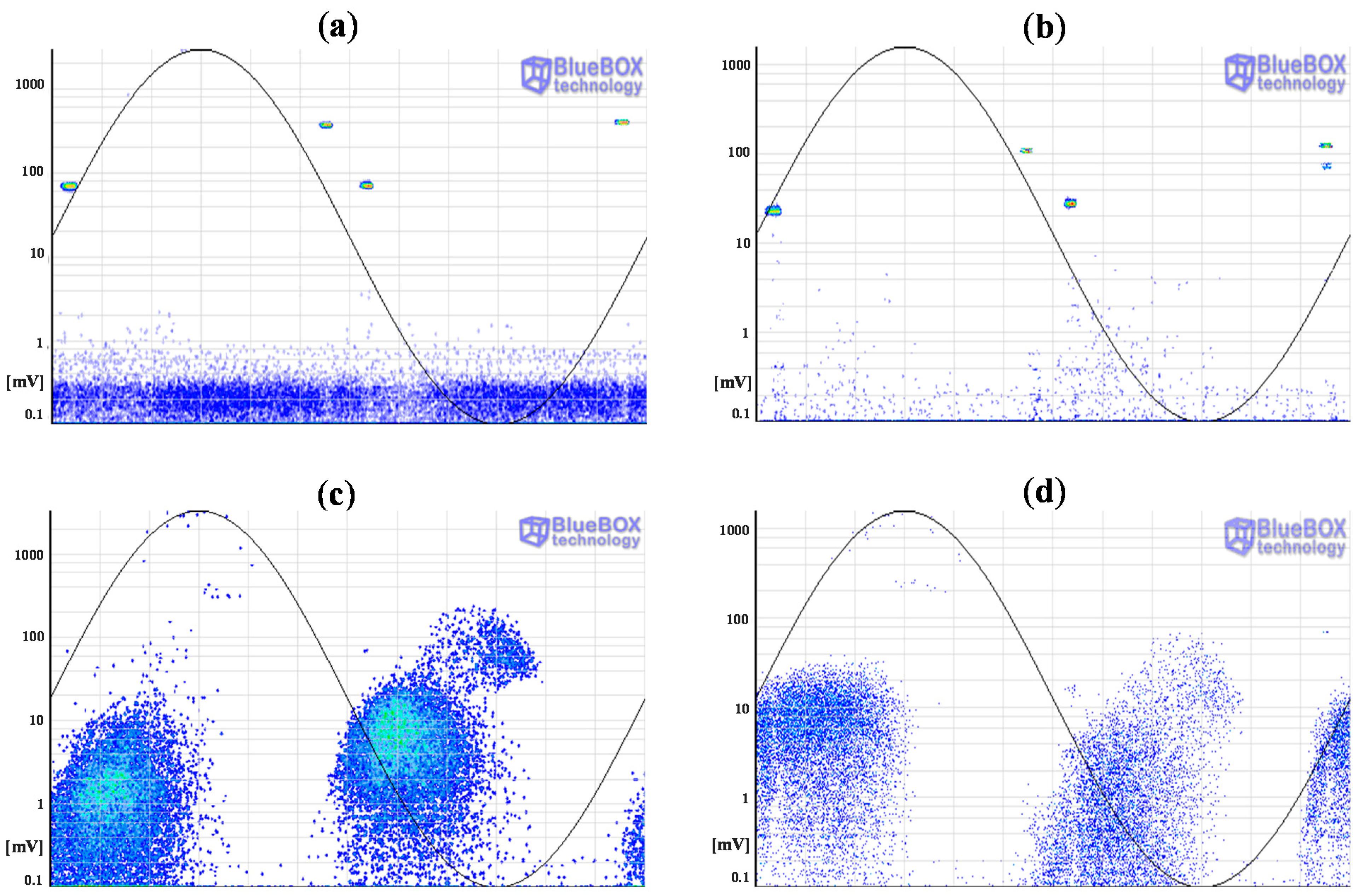



- -
- When the pulses are positioned by the location tool in the same site where a HFCT sensor is coupled the location of the defect can not be totally assured, i.e., the source can be in that position or in a previous one. This is because in both cases the delay in the arrival time of the pulses to the sensors is the same, see Figure 25a,b, so the pulses are always positioned in the emplacement where the HFCT sensor is placed.
- -
- Only when the defect is in an intermediate point between the sensors it can be assured that the positioning of the focus is correct; a certain time delay corresponds only to one emplacement of the PD source, see Figure 25c.
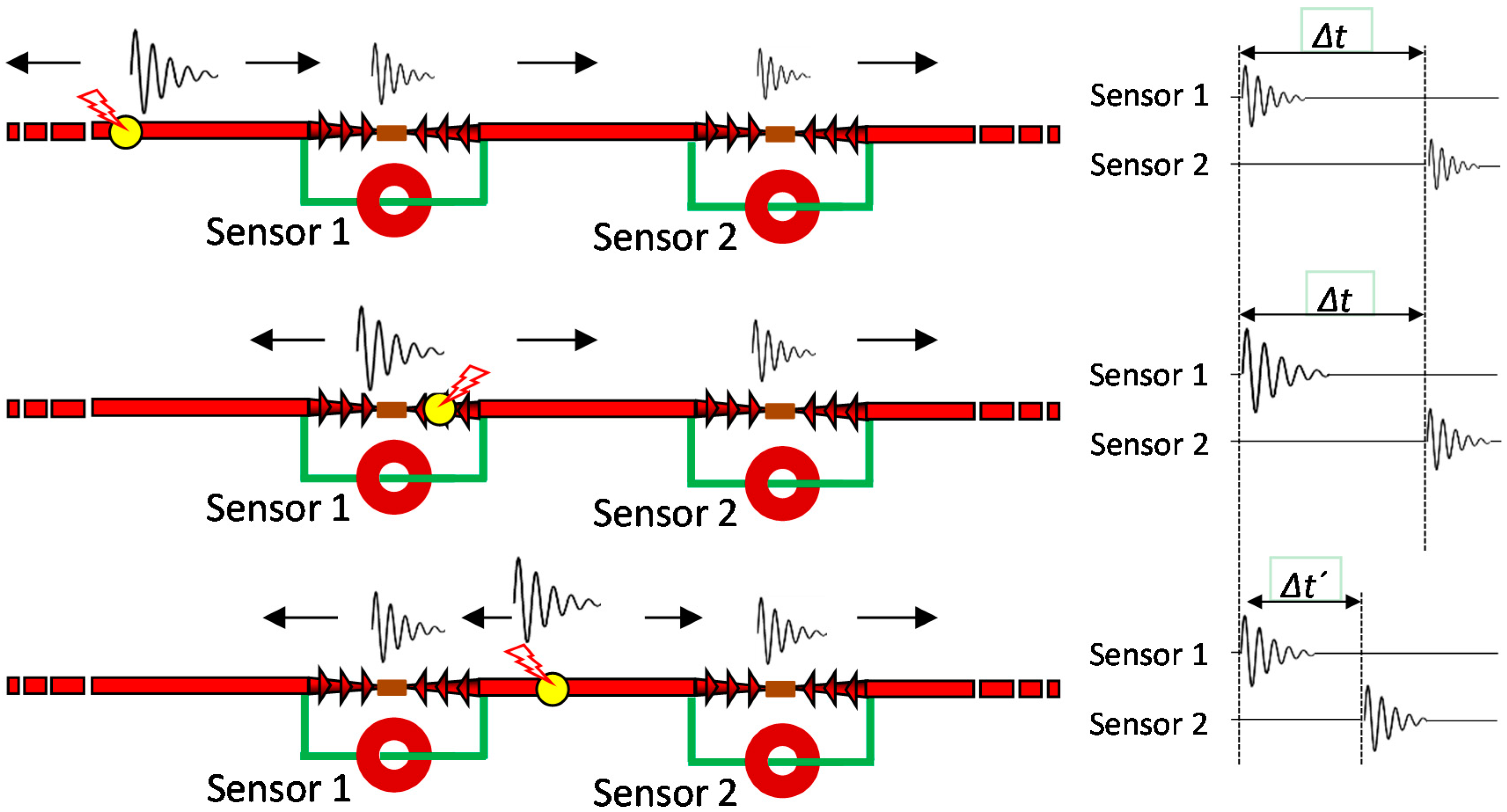

- -
- In position C two types of sources were identified: corona in air and an internal defect.
- -
- The location of the corona defect in position C was ratified. However, the emplacement of the internal defect could not be confirmed.
- -
- In position D an internal defect in a joint was detected and located.
- -
- A corona type PD source related with a tip referenced to ground (cluster 6) was detected with the sensor HFCT 1. The location of this source could not be determined.


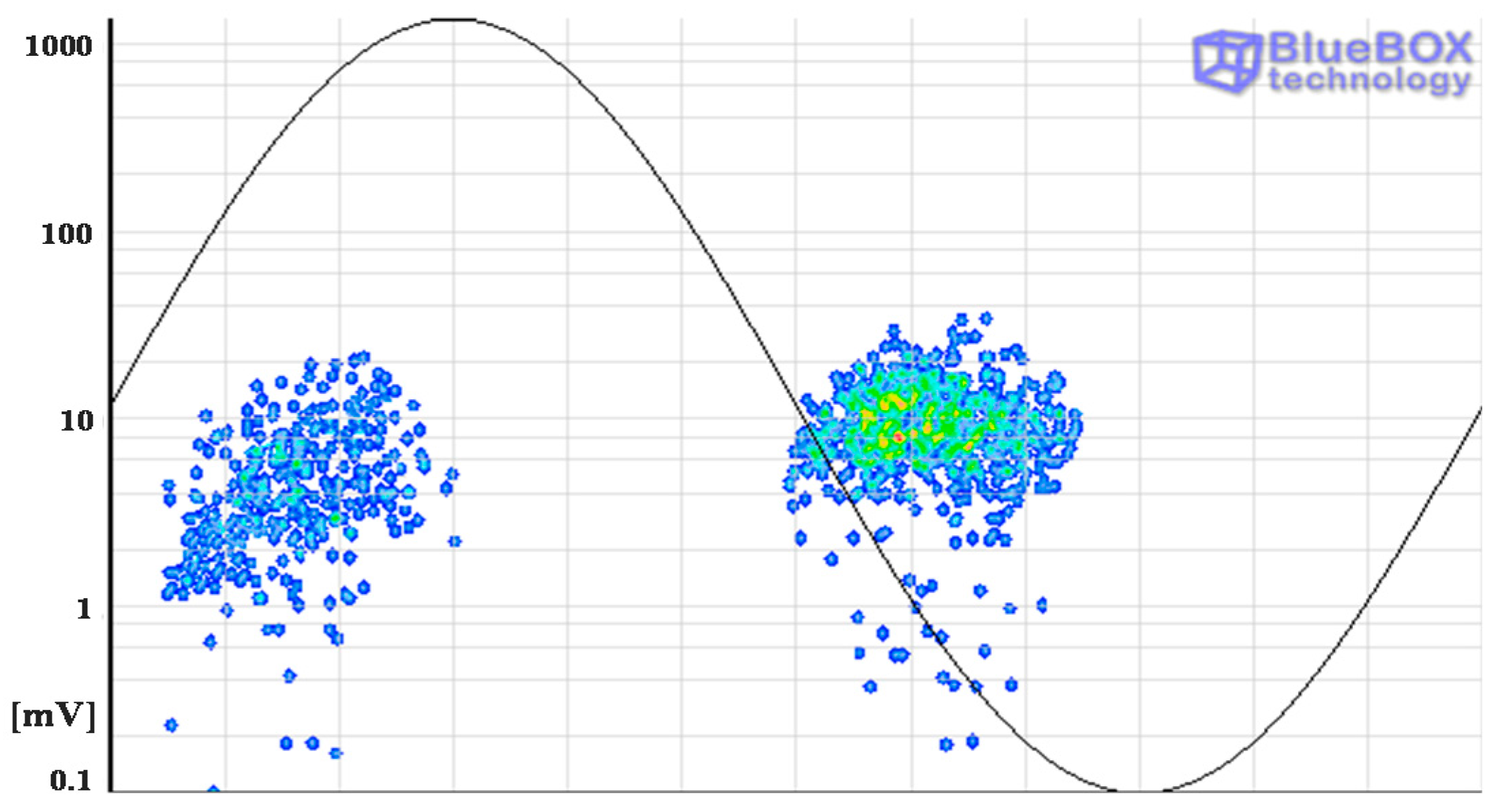
5. Conclusions
Acknowledgments
Author Contributions
Conflicts of Interest
References
- Wester, F. Condition Assessment of Power Cables Using PD Diagnosis at Damped AC Voltages. Ph. D. Thesis, Delft University of Technology, Delft, The Netherlands, 2004; pp. 11–35. [Google Scholar]
- Meijer, S.; Gulski, E.; Smit, J.J. Pattern Analysis of Partial Discharges in SF6 GIS. IEEE Trans. Dielectr. Electr. Insul. 1998, 5, 830–842. [Google Scholar] [CrossRef]
- Fuhr, J. Procedure for Identification and Localization of Dangerous PD Sources in Power Transformers. IEEE Trans. Dielectr. Electr. Insul. 2005, 12, 1005–1014. [Google Scholar] [CrossRef]
- Haddad, A.; Warne, D.F. Advances in High Voltage Engineering, 2nd ed.; IET Power and Energy Series; IET: London, UK, 2007; pp. 37–190. [Google Scholar]
- Tian, Y.; Lewin, P.; Davies, A. Comparison of On-line Partial Discharge Detection Methods for HV Cable Joints. IEEE Trans. Dielectr. Electr. Insul. 2002, 9, 604–615. [Google Scholar] [CrossRef]
- Wang, X.; Li, B.; Roman, H.; Russo, O.L.; Chin, K.; Farmer, K.R. Acousto-optical PD Detection for Transformers. IEEE Trans. Power Deliv. 2006, 21, 1068–1073. [Google Scholar] [CrossRef]
- Wang, L.; Fang, N.; Wu, C.; Qin, H.; Huang, Z. A Fiber Optic PD Sensor Using a Balanced Sagnac Interferometer and an EDFA-Based DOP Tunable Fiber Ring Laser. Sensors 2014, 14, 8398–8422. [Google Scholar] [CrossRef] [PubMed]
- Posada-Roman, J.; Garcia-Souto, J.A.; Rubio-Serrano, J. Fiber Optic Sensor for Acoustic Detection of Partial Discharges in Oil-Paper Insulated Electrical Systems. Sensors 2012, 12, 4793–4802. [Google Scholar] [CrossRef] [PubMed]
- Rodrigo, A.; Llovera, P.; Fuster, V.; Quijano, A. Influence of High Frequency Current Transformers Bandwidth on Charge Evaluation in Partial Discharge Measurements. IEEE Trans. Dielectr. Electr. Insul. 2011, 18, 1798–1802. [Google Scholar] [CrossRef]
- Rodrigo, A.; Llovera, P.; Fuster, V.; Quijano, A. Study of Partial Discharge Charge Evaluation and the Associated Uncertainty by Means of High Frequency Current Transformers. IEEE Trans. Dielectr. Electr. Insul. 2012, 19, 434–442. [Google Scholar] [CrossRef]
- Stone, G. Partial Discharge—Part VII. Practical Techniques for Measuring PD in Operating Equipment. IEEE Electr. Insul. Mag. 1991, 7, 9–19. [Google Scholar] [CrossRef]
- Cavallini, A.; Montanari, G.; Contin, A.; Pulletti, F. A New Approach to the Diagnosis of Solid Insulation Systems Based on PD Signal Inference. IEEE Electr. Insul. Mag. 2003, 19, 23–30. [Google Scholar] [CrossRef]
- Ardila-Rey, J.; Martínez-Tarifa, J.M.; Robles, G.; Rojas-Moreno, M. Partial Discharge and Noise Separation by Means of Spectral-Power Clustering Techniques. IEEE Trans. Dielectr. Electr. Insul. 2013, 20, 1436–1443. [Google Scholar] [CrossRef]
- Ardila-Rey, J.A.; Rojas-Moreno, M.V.; Martínez-Tarifa, J.M.; Robles, G. Inductive Sensor Performance in Partial Discharges and Noise Separation by Means of Spectral Power Ratios. Sensors 2014, 14, 3408–3427. [Google Scholar] [CrossRef] [PubMed]
- Gulski, E.; Cichecki, P.; Wester, F.; Smit, J.; Bodega, R.; Hermans, T.; Seitz, P.B.; Quak, B.; Vries, F. On-Site Testing and PD Diagnosis of High Voltage Power Cables. IEEE Trans. Dielectr. Electr. Insul. 2008, 15, 1691–1700. [Google Scholar] [CrossRef]
- Kreuger, F.H.; Gulski, E.; Krivda, A. Classification of Partial Discharges. IEEE Trans. Dielectr. Electr. Insul. 1993, 28, 917–931. [Google Scholar] [CrossRef]
- International Standard IEC 60270. In High Voltage Test Techniques—Partial Discharge Measurements, 3rd ed.; International Electrotechnical Commission: Geneva, Switzerland, 2000.
- Lemke, E. Guide for Partial Discharge Measurement in Compliance to IEC 60270 Std, CIGRE Technical Brochure; CIGRE, 2008. Available online: http://www.e-cigre.org/Order/select.asp?ID=13723 (accessed on 23 March 2015).
- Tumanski, S. Induction coil sensors: A review. Meas. Sci. Technol. 2007, 18, 31–46. [Google Scholar]
- IEEE Std. 400.3. In IEEE Guide for Partial Discharge Testing of Shielded Power Cable Systems in a Field Environment; IEEE: New York, NY, USA, 2006.
- Shibuya, Y.; Matsumoto, S.; Tanaka, M.; Muto, H.; Kaneda, Y. Electromagnetic Waves from Partial Discharges and their Detection Using Patch Antenna. IEEE Trans. Dielectr. Electr. Insul. 2010, 17, 862–871. [Google Scholar] [CrossRef]
- Reid, A.J.; Judd, M.D.; Stewart, B.G.; Fouracre, R.A. Partial discharge current pulses in SF6 and the effect of superposition of their radiometric measurement. J. Phys. D: Appl. Phys. 2006, 39, 4167–4177. [Google Scholar] [CrossRef]
- Lemke, E.; Gulski, E.; Hauschild, W.; Malewski, R.; Mohaupt, P.; Muhr, M.; Rickmann, J.; Strehl, T.; Wester, F.J. Practical Aspects of the Detection and Location of Partial Discharges in Power Cables; CIGRE Technical Brochure. CIGRE, 2005. Available online: http://www.e-cigre.org/Order/select.asp?ID=9303 (accessed on 23 March 2015).
- Judd, M.D.; Yang, L.; Hunter, I.B.B. Partial Discharge Monitoring of Power Transformers Using UHF Sensors. Part I: Sensors and Signal Interpretation. IEEE Electr. Insul. Mag. 2005, 21, 5–14. [Google Scholar]
- Lopez-Roldan, J.; Tang, T.; Gaskin, M. Optimisation of a Sensor for Onsite Detection of Partial Discharges in Power Transformers by the UHF Method. IEEE Trans. Dielectr. Electr. Insul. 2008, 15, 1634–1639. [Google Scholar] [CrossRef]
- Hoshino, T.; Kato, K.; Hayakawa, N.; Okubo, H. A Novel Technique for Detecting Electromagnetic Wave Caused by Partial Discharge in GIS. IEEE Trans. Power Deliv. 2001, 16, 545–551. [Google Scholar] [CrossRef]
- Kaneko, S.; Okabe, S.; Yoshimura, M.; Muto, H.; Nishida, C.; Kamei, M. Detecting Characteristics of Various Type Antennas on Partial Discharge Electromagnetic Wave Radiating Through Insulating Spacer in Gas Insulated Switchgear. IEEE Trans. Dielectr. Electr. Insul. 2009, 16, 1462–1472. [Google Scholar] [CrossRef]
- Raja, K.; Devaux, F.; Lelaidier, S. Recognition of Discharge Sources Using UHF PD Signatures. IEEE Electr. Insul. Mag. 2002, 18, 8–14. [Google Scholar] [CrossRef]
- Judd, M.D.; Farish, O.; Hampton, B.F. Broadband couplers for UHF detection of partial discharge in gas-insulated substations. IEE Proc. Sci. Meas. Technol. 1995, 142, 237–243. [Google Scholar] [CrossRef]
- Li, T.; Rong, M.; Zheng, C.; Wang, X. Development Simulation and Experiment Study on UHF Partial Discharge Sensor in GIS. IEEE Trans. Dielectr. Electr. Insul. 2012, 19, 1421–1430. [Google Scholar] [CrossRef]
- Hikita, M.; Ohtsuka, S.; Teshima, T.; Okabe, S.; Kaneko, S. Electromagnetic (EM) Wave Characteristics in GIS and Measuring the EM Wave Leakage at the Spacer Aperture for Partial Discharge Diagnosis. IEEE Trans. Dielectr. Electr. Insul. 2007, 14, 453–460. [Google Scholar] [CrossRef]
- Watkins, J. Circular resonant structures in microstrip. Electron. Lett. 1969, 5, 524–525. [Google Scholar] [CrossRef]
- Shen, L.; Long, S.A.; Allerding, M.; Walton, M. Resonant Frequency of a Circular Disc, Printed-Circuit Antenna. IEEE Trans. Antennas Propag. 1977, 25, 595–596. [Google Scholar] [CrossRef]
- Long, S.A.; Shen, L.C.; Morel, P.B. Theory of the circular-disc printed-circuit antenna. Proc. Inst. Electr. Eng. 1978, 125, 925–928. [Google Scholar] [CrossRef]
- Zhang, S.; Zheng, X.; Zhang, J.; Cao, H.; Zhang, X. Study of GIS Partial Discharge On-line Monitoring Using UHF Method. In Proceedings of the International Conference on Electrical and Control Engineering (ICECE), Wuhan, China, 25–27 June 2010; pp. 4262–4265.
- Shu, E.W.; Boggs, S. Dispersion and PD Detection in Shielded Power Cable. IEEE Electr. Insul. Mag. 2008, 24, 25–29. [Google Scholar] [CrossRef]
- Garnacho, F.; Sánchez-Urán, M.A.; Ortego, J.; Álvarez, F.; Perpiñán, O.; Puelles, E.; Moreno, R.; Prieto, D.; Ramos, D. New Procedure to Determine Insulation Condition of High Voltage Equipment by Means of PD Measurements in Service. In Proceedings of 44th International CIGRE Session, Paris, France, 26–31 August 2012.
- Shim, I.; Soraghan, J.J.; Siew, W.H. Detection of PD Utilizing Digital Signal Processing Methods. Part 3: Open-Loop Noise Reduction. IEEE Electr. Insul. Mag. 2001, 17, 6–13. [Google Scholar] [CrossRef]
- Ma, X.; Zhou, C.; Kemp, I.J. Automated Wavelet Selection and Thresholding for PD Detection. IEEE Electr. Insul. Mag. 2002, 18, 37–45. [Google Scholar] [CrossRef]
- Meijer, S. Partial Discharge Diagnosis of High-Voltage Gas-Insulated Systems. Ph.D. Thesis, Delft University, Delft, The Netherlands, November 2001. [Google Scholar]
© 2015 by the authors; licensee MDPI, Basel, Switzerland. This article is an open access article distributed under the terms and conditions of the Creative Commons Attribution license (http://creativecommons.org/licenses/by/4.0/).
Share and Cite
Álvarez, F.; Garnacho, F.; Ortego, J.; Sánchez-Urán, M.Á. Application of HFCT and UHF Sensors in On-Line Partial Discharge Measurements for Insulation Diagnosis of High Voltage Equipment. Sensors 2015, 15, 7360-7387. https://doi.org/10.3390/s150407360
Álvarez F, Garnacho F, Ortego J, Sánchez-Urán MÁ. Application of HFCT and UHF Sensors in On-Line Partial Discharge Measurements for Insulation Diagnosis of High Voltage Equipment. Sensors. 2015; 15(4):7360-7387. https://doi.org/10.3390/s150407360
Chicago/Turabian StyleÁlvarez, Fernando, Fernando Garnacho, Javier Ortego, and Miguel Ángel Sánchez-Urán. 2015. "Application of HFCT and UHF Sensors in On-Line Partial Discharge Measurements for Insulation Diagnosis of High Voltage Equipment" Sensors 15, no. 4: 7360-7387. https://doi.org/10.3390/s150407360
APA StyleÁlvarez, F., Garnacho, F., Ortego, J., & Sánchez-Urán, M. Á. (2015). Application of HFCT and UHF Sensors in On-Line Partial Discharge Measurements for Insulation Diagnosis of High Voltage Equipment. Sensors, 15(4), 7360-7387. https://doi.org/10.3390/s150407360






